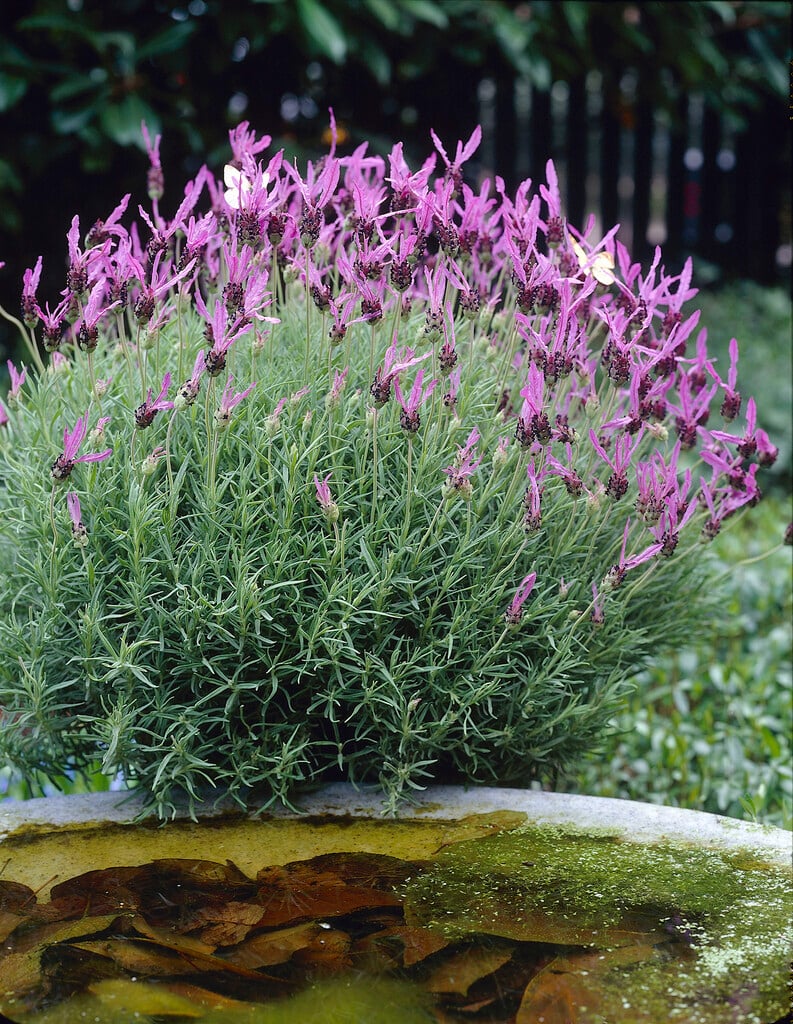Lavandula pedunculata subsp. pedunculata
French lavender
A bushy evergreen shrub with narrow, grey-green leaves, and small violet flowers in long-stalked, dense ovoid heads tipped with large purple bracts
Other common names
butterfly lavenderSynonyms
Lavandula 'Butterfly'Lavandula stoechas 'Papillon'
see moreLavandula stoechas 'Butterfly'
Lavandula stoechas subsp. pedunculata
Size
Ultimate height
0.5–1 metresTime to ultimate height
2–5 yearsUltimate spread
0.5–1 metresGrowing conditions
Moisture
Well–drainedpH
Acid, Alkaline, NeutralColour & scent
| Stem | Flower | Foliage | Fruit | |
| Spring | Purple | Grey Silver Green | ||
|---|---|---|---|---|
| Summer | Purple | Grey Silver Green | ||
| Autumn | Grey Silver Green | |||
| Winter | Grey Silver Green |
Position
- Full sun
Aspect
West–facing or South–facing
Exposure
Sheltered Hardiness
H3Botanical details
- Family
- Lamiaceae
- Native to GB / Ireland
- No
- Foliage
- Evergreen
- Habit
- Bushy
- Genus
Lavandula are small aromatic evergreen shrubs with usually narrow, simple, entire, toothed or lobed leaves and small tubular flowers in dense spikes in summer
- Name status
Correct
- Plant range
- Iberian peninsula
How to grow
Cultivation
Thrives in well-drained, ideally slightly alkaline soil; will not tolerate waterlogging. In warmer regions, may be planted out in a sunny, sheltered position with winter protection. In areas prone to frost, grow in containers and overwinter in a greenhouse or conservatory. See lavender cultivation for more advice
Propagation
Propagate by seed or semi-hardwood cuttings
Suggested planting locations and garden types
- City and courtyard gardens
- Coastal
- Cottage and informal garden
- Patio and container plants
- Wildlife gardens
- Mediterranean climate plants
- Conservatory and greenhouse
Pruning
Pests
May be susceptible to rosemary beetle and cuckoo spit (froghoppers)
Diseases
High Risk Host for Xylella fastidiosa. May be susceptible to grey moulds (Botrytis) and honey fungus (rarely)
Love gardening
Sign up to receive regular gardening tips, inspiration, offers and more
View our Privacy Policy
Get involved
The Royal Horticultural Society is the UK’s leading gardening charity. We aim to enrich everyone’s life through plants, and make the UK a greener and more beautiful place.

